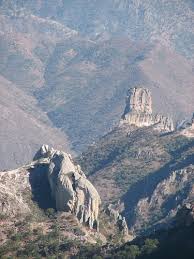
Helen and I both just finished reading Chris McDougall's Born to Run. And both of us liked it quite a bit – probably I more than Helen, who found it good but self-serving. But, then, she finished it pretty quickly, too, and even started running around the street without her shoes on lately. Hard to believe that's a coincidence.
One of the most impressive aspects of the book, for me, is the way that it's got so much going on in it, while being such a page-turner. Yes, it's about running. But to be more specific, it's about:
-a tribe of indigenous Mexicans, the Tarahumara
-why shoes are bad
-the ultra-running community, and ultrarunning's evolution as a sport
-how we should run on our midfoot
-who we are as human beings
-traveling in some really remote and dangerous areas of Mexico
-how homo-sapiens defeated the neanderthals (hint: it's got to do with running)
-an 'underground' ultra in rural Mexico
-Chris McDougall himself
It's hard to get that many themes into one book. And yet, there's another list of what the book is about, running paralell to the first list: it's about Scott Jurek, about Bill and Jenn, and about Ann Trason; it's about Joe Vigil and Barefoot Ted and Arnulfo Quimare. It's about the scores of people – runners, explorers, biologists – whom McDougall brings to life through his writing. Above all, it's about a guy known as Caballo Blanco, a white guy living down near, but not among, the Tarahumara. And, yes, it's about McDougall, and his path from oft-injured wannabe runner to barefoot ultra runner.

Running is the one theme running through all of the book. Running really really long distances. One of the book's arguments is that humans evolved as distance runners, using some sort of 'persistence hunting' to track down large animals. So tribes that still do distance running are remnants of our prehistoric past, and events like the Leadville 100 or Western States are a way of humans returning to their original evolutionary purpose. Even marathons – writing about this book, marathons wind up sounding short, even for someone like me who's never run farther than that – represent some sort of biological urge to go back to our roots.
As anthropology, the book isn't great. It's got a lot of the really old anthro, or pop-anthro, with its fetishism of origins: that the Tarahumara are a glimpse at humans as they used to be, somehow closer to the "essence of man"; that there is only value in discovering cultures as they used to be before being contaminated by modernization; you can even add in the view of annual rituals as "safety valves." In anthropology today, you can't make those kinds of arguments. Even in the 1960s, they were pretty outdated. And it could well be that the evolutionary theory and the biological theory are just as weak, it's just too far out of my realm of expertise for me to know.
Still, having said that, I'm very impressed with the book. And I say that more as a writer than as a runner.

McDougall at Vally Green with Bob R
As a runner, I'm not sure what to make of this. For McDougall, humans are meant to run on their forefoot. Running shoes with padded heels give us injuries and weak feet. But I've been running for several years now, and (knocking on wood) I've stayed pretty healthy. I wear cushy shoes, I land on my heel. I do everything wrong, according to this book. But, then, a lot of people do. I'll take another look at this if I become more injury prone. For, now, though, if it ain't broke, don't fix it. But I'll say this: while reading the book, it's really, really convincing. I can't imagine finishing the book and not wanting to run an ultra while landing on my midfoot.
How do you write a book that includes whole sections about evolutionary biology and not make it boring? How do you write a book that inspires people to do something so crazy as running up and down mountains at night? And – for me, this is one of the biggest questions – how do you write such a riveting book that contains so many themes?
I had a similar reaction around 10 years ago, when I read Friday Night Lights. Both are non-fiction written by journalists. Both of them manage to have a huge number of themes running through them. There are just more arguments here than you can pull off in an academic book, without having that book turn into something totally unreadable, without writing something that reads like the Theory of Communicative Action.
It seems to me that there are two keys. One is that, freed from the constraints of academic writing, you can include more suggestive arguments rather than conclusive ones. You can make claims meant to provoke thought rather than to pass peer reviews. And the second key is the characters. You wind up having such a good sense of these people by the end of the book. Without these characters, there's no way that this book – that either book – would be so riveting.
No comments:
Post a Comment